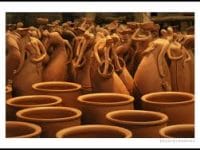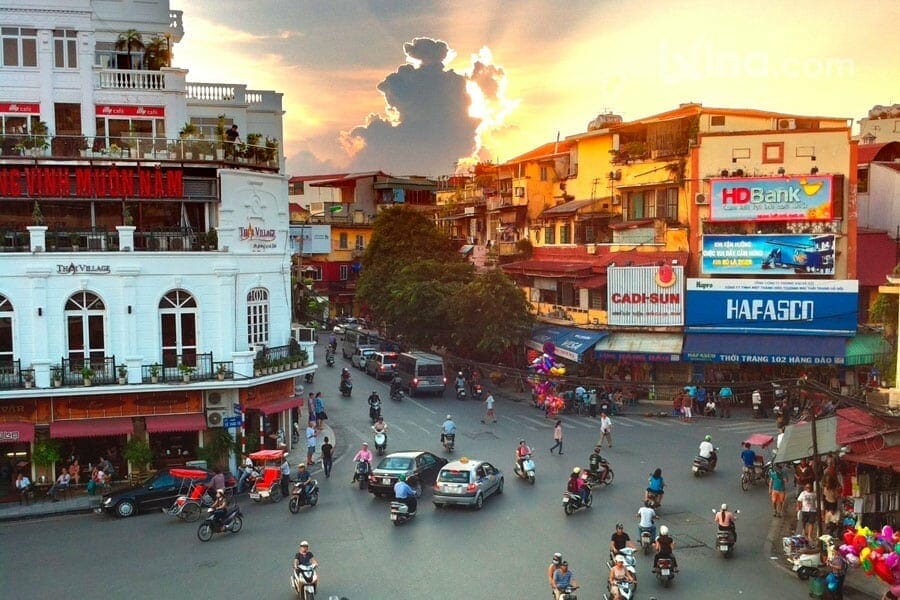VietNamNet Nosepiece – Phan Van Toai, a craftsman in Phu Lang ceramics settlement in the union orbit of Bac Ninh, has been busier than wonted during the weekends  after actuation a new pair to pioneer foxiness making to tourists at his own instrumentality workshop.
after actuation a new pair to pioneer foxiness making to tourists at his own instrumentality workshop.
Toai, 28, is the fifth procreation of his kin to wee ceramics in the village, 60km east of Ha Noi’s confection. It takes some an distance by bus to get to the settlement from downtown.
Phu Lang has begun welcoming tourists on day trips from the capital over the past two years and has been included on the tourism map as the third most famous ceramic village in the north.
The village, which was settled as a craft centre in the Hong (Red) River Delta in the 14th century, offers travellers the opportunity to explore a typical rural handicraft lifestyle in the northern delta.
“I’ve been working in the workshop since I was seven. My hands are busy with clay all day with modelling sculptures, jars, pots and various ceramic products, but now I also introduce the process of making ceramics to visitors who flock to the village on weekends,” said Toai.
Toai’s workshop and those of his neighbours are major destinations for tourists interested in visiting the village and exploring the trade, which has been a part of the community for centuries.
The village administration is promoting the trade with an aim to boost tourism and interest in ceramics.
“I hope to introduce the craft to tourists from around the world whenever they come to visit the village. Tourism would increase my income because I would produce more ceramic souvenirs,” Toai said.
The craftsman also teaches visitors how to work with the clay.
 “I teach them how to form things with their hands and a slab-roller. It allows them to do a bit of handicraft work during their visit,” he said.
“I teach them how to form things with their hands and a slab-roller. It allows them to do a bit of handicraft work during their visit,” he said.
Interest in the village has grown recently after it was featured on a popular English-language travel programme on Bulgarian national television called No Luggage.
Nguyen Van Hoa, a tour manager from Ha Noi-based Focus Travel, said Phu Lang is a popular spot with tourists.
“We include the village as a favourite stop for tourists on their return to the capital after a trip to Ha Long Bay. It offers a few hours for tourists to relax their minds and explore the rural life in the ceramic village,” Hoa said.
“Just 3km off the main road, visitors can find a tranquil rural life filled with fantastic clay art works,” he added.
Nguyen Manh Anh, a freelance tour guide, said the village is a very new destination in the north while Bat Trang Ceramic Village has been well-known for years as one of the most visited site in Ha Noi.
“Phu Lang Village is quieter than Bat Trang, possibly because it takes longer to get here. Roads in the village are a bit challenging for a 45-seat coach, but vans can get through just fine. I think tourists will gain an angle on the craft trade and a rural lifestyle that has been present in the village for centuries,” Anh said.
Art of clay
Craftsmen in Phu Lang use red clay, which makes the local ceramic products different from those made by the villages of Bat Trang, Tho Ha and Chu Dau, which are also famous for their ceramic works.
Enamel and a firewood kiln are two of the top secrets that help dye the village’s products extraordinary dark greens and dull reds.
Craftswoman Nguyen Thi Tu, 58, explained that the enamel was made from a diluted mixture of ash, mud, clay and water.
“It’s very simple, but the ratio between materials is the most important secret that local craftsmen inherited from their ancestors. It has been passed down since the 14th century,” Tu said.
“The artistry of the local craftsmen and their skilful work are strong features of the local pottery.”
The host has carefully set up his workshop to wow sightseers. Tourists find it easy to see the process of how ceramic artists create a product: from grinding the clay to modelling the product on a slab-roller. When the workers have a day off, tourists can explore the kiln which fires up to 800 products at a time.
Dang Thi Linh, a worker working at the Cuong Gallery, said she got a workout every time she kneaded clay and formed jars on the potter’s wheel.
“Most women work with slab-rollers because our hands are softer than men’s. Sometimes I sculpt or draw on clay pots or jars before setting them in the kiln,” she said.
Nghiem Minh Cuong, 31, the workshop owner, said he focused on making artistic products such as ceramic pictures, garden decorations and sculptures.
“We engrave a big picture on a flat clay panel and dry it in the sunlight before painting it with colours. It is then cut into pieces and fired at a temperature of 1,200oC. Burnt pieces of the picture can be resettled with glue but colourful pictures last forever,” Cuong said.
He said tourists enjoyed doing their own pottery in his shop as well.
The village has been a sightseeing destination for European travellers for the past two years, ever since the village administration boosted tourism services.
“The increased number of tourists flocking to the village will be an encouragement for local craftsmen, not only for money from souvenir sales, but also for the development of more creativity in art works. The pottery is our lifestyle and we are proud of our long, traditional trade,” said Toai.



